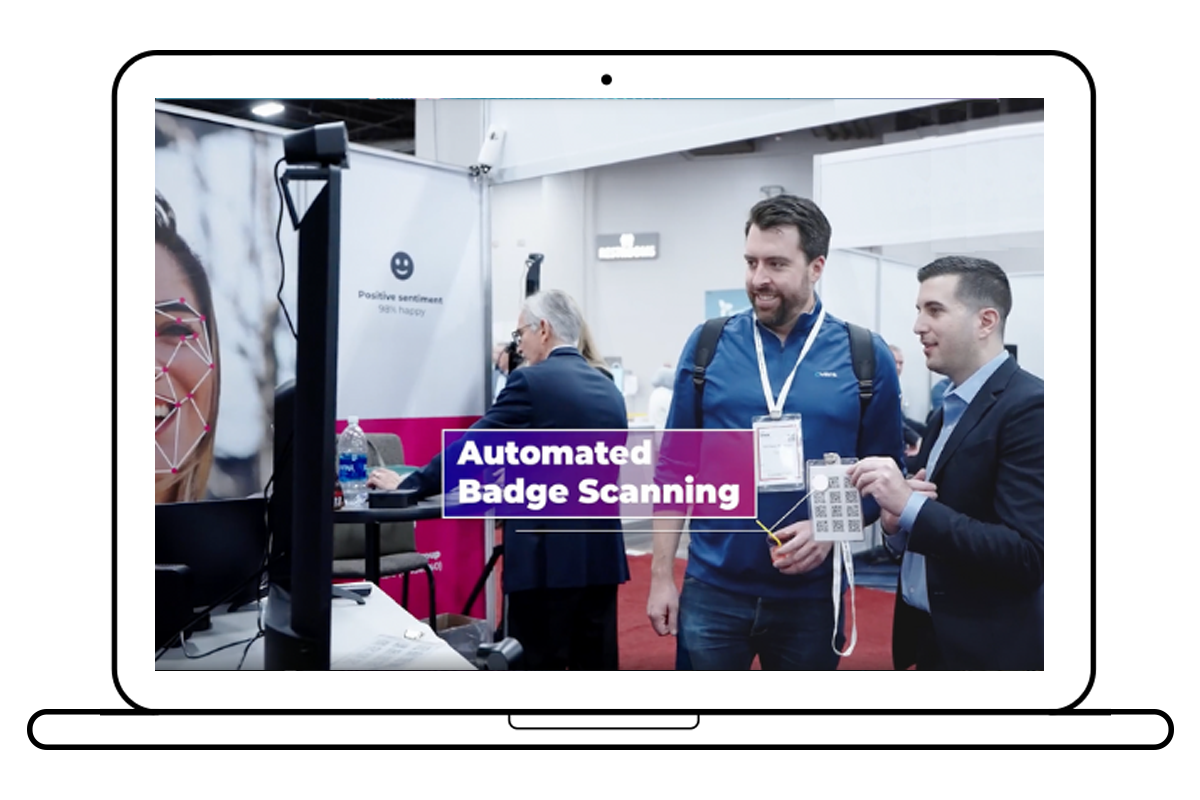Zenus AI Badge Scanning and Facial Analysis [Review]
Disclaimer: Skift Meetings receives a fee to review this product. The content below is verified for accuracy and aims to provide an objective look at the product’s key features, potential uses, and pricing, among other factors.
Zenus AI has created a new attendee tracking solution that can be integrated with its ethical facial analysis software. Designed to scan and track attendee badges throughout the event space, this new product comes packaged as a plug-and-play hardware kit connected to a real-time analytics dashboard. Use cases include targeted follow-ups, mapping of the attendee journey, personalization of the attendee experience, and smart lead generation.
What Is It?
Zenus’ event data solution combines a camera-based system for monitoring attendee movements (via badge scans) and measuring sentiment (via facial analysis) with a secure first-party data analysis platform, providing insight into event attendees’ behavior and level of interest.
Using camera equipment to scan coded attendee badges, the system monitors how attendees move through the event space, when they stop, and for how long. It can also quantify the attendee experience by aggregating AI-powered facial analysis data to measure positive sentiment and other markers of engagement.
While the badge scanning feature monitors attendee movements, it provides multiple privacy safeguards that protect PII (personally-identifying information). Only the event organizer has access to the PII associated with each attendee ID, and there is always the option to opt out. Additionally, all video recordings are processed onsite using the Zenus AI hardware kit, with only the anonymized data analysis shared to the cloud.
Notably, this attendee tracking ability can be integrated with Zenus’ facial analysis data, adding another level of insight into specific market segments. For instance, it can track whether C-Suite attendees demonstrated high levels of “delight” at a specific exhibit, and where they went next.
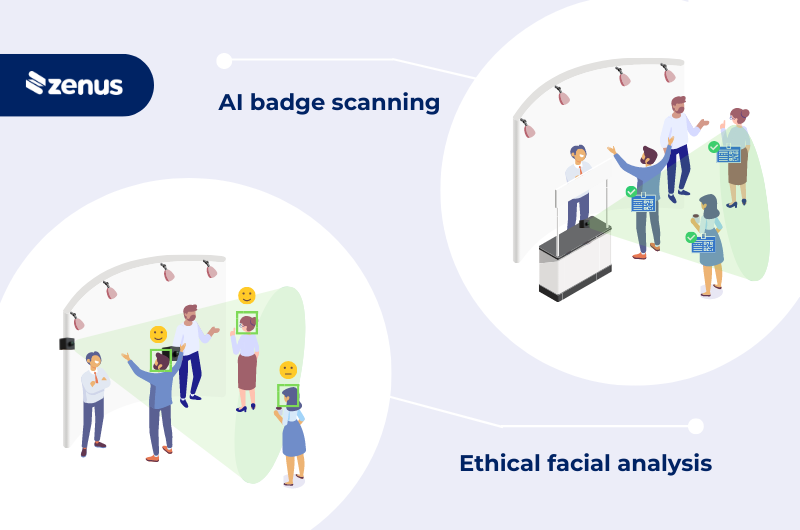

Show floor applications include monitoring of attendee interest in specific exhibitor booths or speaker sessions, attendee journey data gathering, personalization of content shown on live display screens, access control, and improved lead tracking. Zenus’ attendee tracking and facial analysis solutions can be licensed as a package or as individual services.
Main Features
Plug-and-Play Set Up:
The AI hardware that Zenus provides can be set up in a short period of time — taking on average about 15 minutes per sensor — without any technological expertise. Shipping out at 13x9x2.5 inches and 4 pounds, each kit comes with the necessary cables and cellular connectivity. The kit includes a webcam but is also compatible with any digital camera.
The distance at which a face or badge can be captured and scanned will vary depending on the quality of the camera you use. For badge scanning purposes, the kit’s high resolution webcams typically have a six-foot range, whereas better cameras can be accurate from a distance of up to 12-15 feet away. The range for facial analysis is much higher, with the kit’s webcam capturing details up to 30 feet away and better cameras accurate up to an 80-foot range. The kit is enabled to capture either QR/barcode scans or facial analysis.
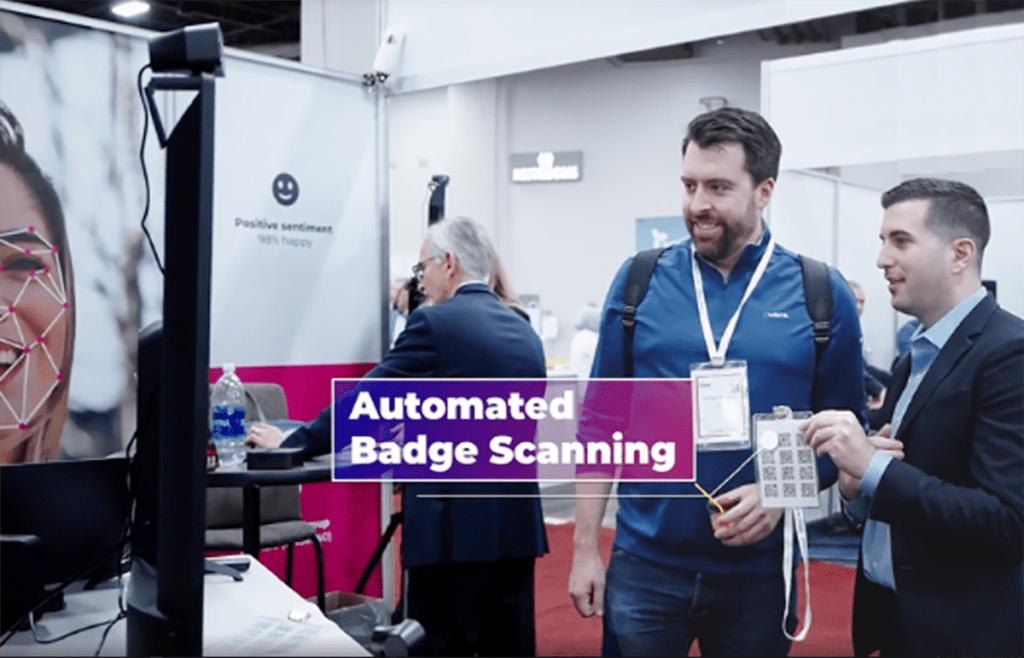

Session Attendance Tracking and Automated Access Control:
Many large-scale events are using QR-code badges to gather key metrics — like session attendance — by scanning badges at access points. Zenus’ system can offer a similar depth of data capture without requiring manual scanning of attendee badges. When combined with turnstiles or lightly supervised soft check-in tablets, this system can also be used for access control.
Automated Lead Generation and Scoring Backed by High-Value Data:
Because Zenus’ product combines data on unique visitors, repeat visitors, and dwell time with an analysis of attendee sentiment levels as they chart their course through an event, it offers another dimensionality than alternative attendee tracking systems. This multi-pronged approach enables the event organizer to gauge what attendees are interested in, sorting the data either by individual attendee or by more general professional/demographic categories. This kind of first-party data can enable more precise lead scoring and inform highly individuated follow-ups.
AI-Powered Facial Analysis for Sentiment Tracking:
Zenus captures aggregated facial analysis of positive sentiment and other key expressions, with the option to break the analysis down into demographic groups (e.g., by biological sex, age bracket). Zenus’ software addresses the potential pitfall of varying levels of facial expressiveness between individuals by tracking “positive sentiment,” a metric that assesses emotional cues on a person-by-person basis.
It works by monitoring individual facial features as they change over time in order to establish the baseline norm on an attendee-by-attendee basis. (For instance, some people may frequently use a closed-mouth smile to express mild interest, while more reserved attendees may use a similar expression only occasionally to show significant interest.) Because this data is anonymized and aggregated by an AI program, it allows event organizers to combine privacy protections with a more accurate assessment of attendee engagement than many other existing measurement tools offer.
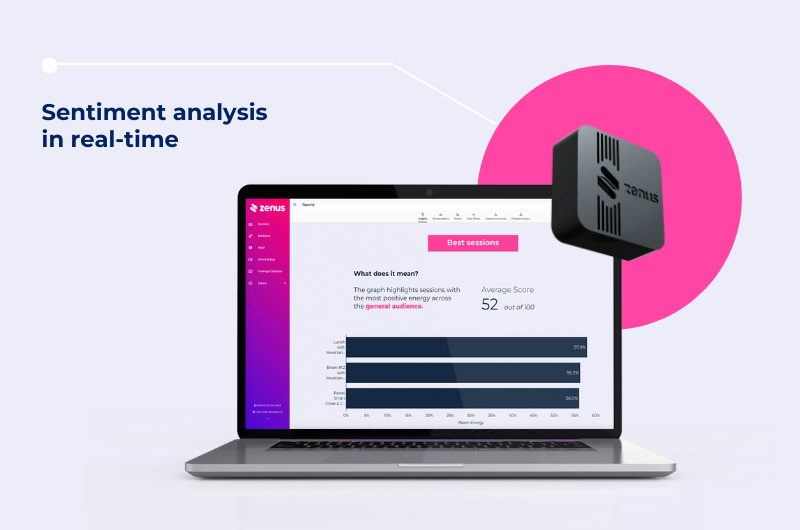

Real-Time Behavioral Analytics and Attendee Tracking:
The combined potential of QR badge scanning and facial analysis provides a nuanced and real-time capture of the attendee experience. Metrics like stop-rate, dwell-time, sentiment, and intent can be measured simultaneously and analyzed in near-real-time. Depending on your data strategy, Zenus’ system is able to facilitate custom first-party data capture programs.
Adaptive, Personalized Content:
Both Zenus’ badge scanning and facial analysis service can be used to create a personalized attendee journey at the onsite venue. If, for example, basic professional details are associated with the attendee badge, exhibitor booth screens can show content that is most suited to an attendee’s job role when they stand in front of a dedicated badge-scanning sensor. Facial analysis can work in a similar way by identifying the individual’s demographic category — such as their general age range — and provide targeted messaging accordingly.
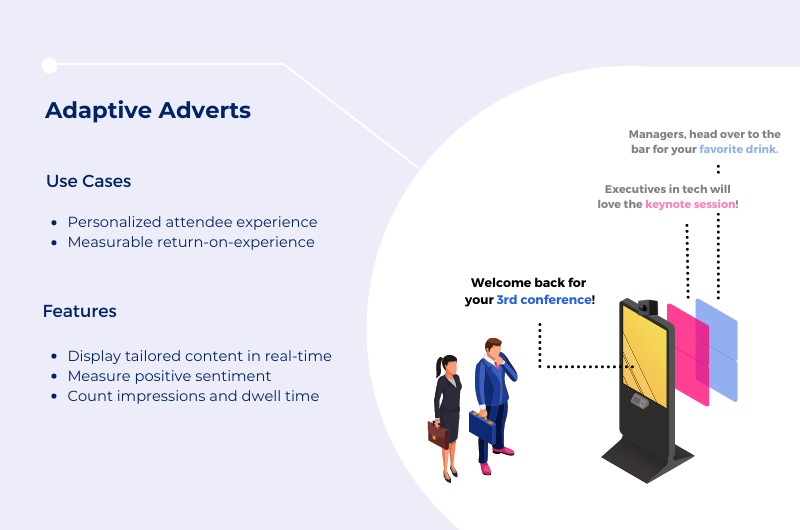

Multiple Back-Up Safeguards and Disconnection Alerts:
The system comes with cellular connectivity; while this removes dependency on your venue’s bandwidth, WiFi connectivity can also be set up as a fallback option. It’s also worth noting that because no video content is ever transmitted via the internet, the system uploads about 1MB of data per hour (less than what is typically required for a single photo).
All of these factors help to minimize the likelihood of internet connectivity crashing at a heavy-traffic event. It also minimizes costs associated with running ethernet cables required by other solutions. It will even work offline and with an external battery pack (optional add-on), and it retains two local encrypted data backups (on the device’s embedded storage and on a USB stick). If all else fails, the data won’t be lost. And in the event that a cable connecting the camera to the system is manually unplugged, the identified data manager — usually the event organizer or their team — is immediately notified via email and text.
Robust Privacy Safeguards:
Although its technology relies on camera captures, Zenus does not store or transmit any of the recordings over the internet. Instead, the video feeds are connected to an onsite data-processing device (a “smart box” or “AI box”) via cables. Once the live feed is processed into key metrics (such as dwell time and intent level scores), the data is transmitted over the cloud using the cellular network. The event organizer can then cross-reference these metrics with attendee IDs, but any personally-identifying information obtained through the system’s video scans will never be accessible to Zenus staff or its servers.
Further, Zenus provides and recommends protocols that offer attendees the option to opt in or out at the point of registration, in a manner similar to a website’s pop-ups requesting permission to use cookies. Traditional signage is another option that can increase awareness and ensure consent.
Review
Zenus’ system is more cost-effective than other attendee tracking alternatives, and it requires minimal set-up time. While its reliance on camera captures may raise privacy concerns for some, Zenus is careful to protect PII (personally-identifying information) and does not store or transmit any video recordings.
Data for Lead Capture, ROI Reporting, and Content Analysis
Given its unique combination of attendee journey tracking with facial analysis, it is a promising tool for event organizers looking to take their data strategy to the next level with more nuanced reporting on ROI for stakeholders, exhibitors, and sponsors alike. The depth of first-party data available may be especially useful for lead capture and scoring.
The potential for targeted follow-ups also meets another key need: the ability to make informed decisions about what type of content is most likely to engage attendees after the event. These insights could be used to nurture a year-round online community, or to fine-tune future event content.
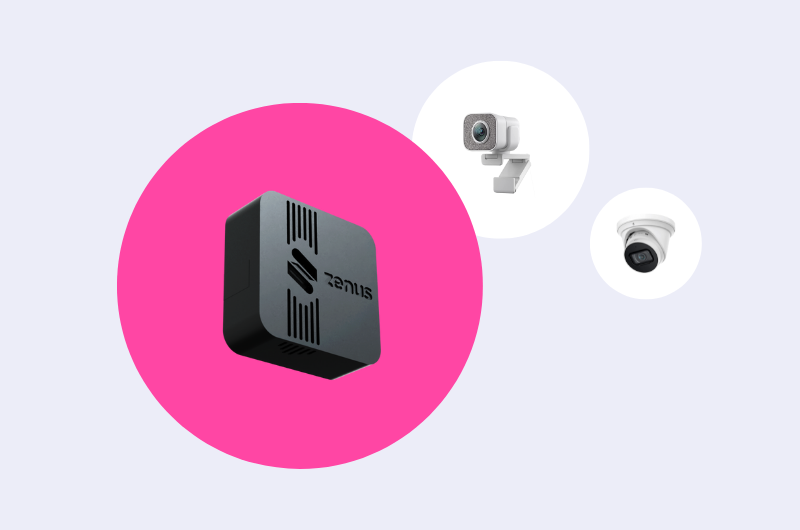

Logistical Pros and Cons
This technology also offers a potential workaround for the logistical difficulties that larger-scale events encounter regulating point-of-access. Automating access control creates efficiencies for event organizers and, potentially, less friction for attendees.
However, it’s important to note that cameras can’t scan around corners or immediately behind attendees. Especially at access points, event organizers will have to be strategic about how they manage the flow of traffic and the placement of cameras. Working closely with the technology provider, implementing their best practices, and starting with a small test can alleviate unnecessary stress.
Privacy and Identity Concerns
Another factor to consider is the potential for attendees to feel uneasy with the depth of data capture that Zenus’ solution enables. It’s worth noting, however, that none of the video content itself is either stored or transmitted. While the system does track attendee movements, it is no different in this respect from traditional RFID, NFC, or BLE solutions. The opt out rate for RFID tracking typically drops to less than 1 percent for repeat events, according to information provided by an industry expert. Although Zenus’ AI-powered facial analysis provides unique audience insights, this data set is fully anonymized.
To minimize knee-jerk reactions to camera-enabled monitoring, if any, event organizers would need to think carefully about how to communicate the purpose and functionality of the tech, the privacy safeguards that are in place, and the opt-out options — ideally before attendees get to the door.
Savvy marketers have to walk a fine line between offering personalized content and leaving themselves open to accusations of stereotyping. Hence, organizers would also need to exercise caution when using Zenus’ AI-enabled responsive technologies that rely on demographic categories like age and biological sex, such as onsite screens that display separate messaging to different groups. This kind of tailored content may be best suited to targeting professional categories, such as using a booth screen to display a separate set of product specs to a CFO vs. a CTO.
A Unique Product Offering
With its ability to cross-reference attendee movements against an analysis of sentiment changes over time, Zenus provides event organizers with unique insights into attendee behaviors and preferences. As long as the company’s recommended best practices regarding attendee privacy and informed consent are front and center — and transparently communicated — Zenus’ innovative technology has the potential to improve event ROI along multiple verticals.
Who’s it for?
Zenus’ products are best suited to event organizers looking for aggregate data on attendee preferences, automated access control at scale, and smart lead tracking and scoring for exhibitors. For these reasons, event organizers managing large-scale events of 500+ anticipated attendees, like high-level corporate events and trade shows, may find that it offers a set of solutions to hard-to-crack data analytics problems. It could also be useful for associations striving to continually refine a personalized content strategy for both year-round community members and a repeat audience at annual events.
Who’s it not for?
Any tech that works at the level of aggregate data analysis needs a large sample size to be significant. As a result, Zenus’ aggregated analysis of fluctuations in attendee sentiment over time would be less effective for any gathering with a small audience size.
Pricing and Plans
Although Zenus does not provide public information about its pricing plans, the company can confirm that both badge scanning and facial analysis capacities are available at a significantly lower cost than a conventional RFID or NFC system.
Features
- Attendee scoring: More nuanced data on attendee movements and interests can translate to smarter lead capture and scoring.
- Frictionless access control: QR code badge scans can automate access to dedicated spaces or sessions through a programmed screen signal (or turnstile).
- Real-time assessment of attendee sentiment: AI facial recognition protocol can determine in near real-time how a presentation is landing, and can be analyzed after the fact to identify when attendees connect or disconnect with content.
- Automate credentials: Conferences offering CEUs can avoid cumbersome procedures to award credentials to qualifying participants.
- Robust privacy practices: Event organizers can reassure attendees that their right to privacy is being protected, and international firms can be confident that Zenus’ system operates across a range of legal privacy jurisdictions.
- Opt in/out protocols: A variety of mechanisms help attendees feel in control of what data is being captured.
- Adaptive content: Booth or event-specific screen displays can be configured to present targeted content to attendee categories or even to specific individuals.
- Customization of data capture: The Zenus team can work with you to configure the exact data you want to capture.
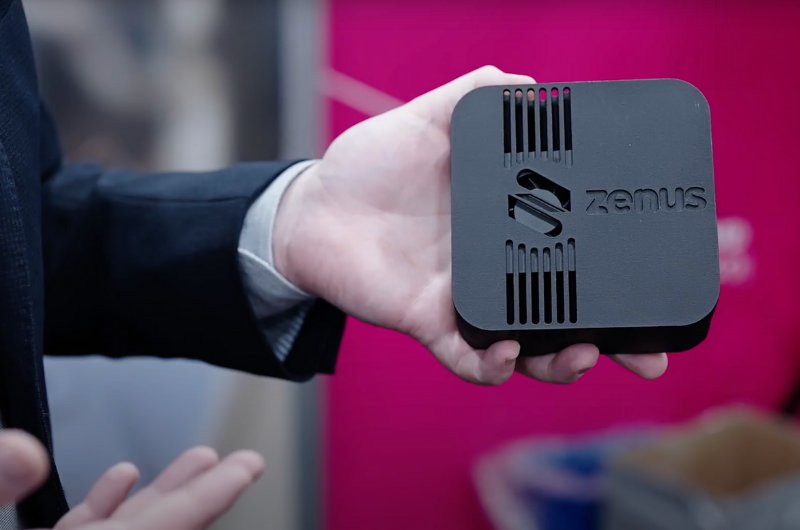

Pros:
- Quick and simple set up: The hardware is small and lightweight for shipping purposes, and it is relatively simple to install.
- Cost-effective: It is priced competitively with existing RFID and NFC systems, while capturing richer data communicated through an easily-understood visualization dashboard.
- Rich data: Multi-faceted capture of attendee behavior reduces reliance on survey mechanisms. The company recommends blending multiple data sources for best results.
- Nuanced ROI reporting: Data integration can facilitate and track leads and CEUs, while also enabling follow-ups. Sentiment measurements can allow insights into brand reach and session engagement.
- Privacy adherence: Because the system translates video recordings into anonymized data reports before anything is transmitted to the cloud, there’s no PII involved.
- Robust back-up safeguards: The system works offline, online, with cellular internet, or in worst-case scenarios, on batteries.
- Mitigates attendee friction: Its badge-scanning tool can automate the management of tiered access.
Cons:
- Unfamiliar tech: Some attendees may be uneasy about the idea of having their badges scanned and their expressions analyzed by camera equipment. Ensuring the highest possible opt-in rates for badge scanning and minimal discomfort with AI analysis may require transparent communication about how the data capture works, what the privacy protections are, and how they can offer an easy opt-out mechanism.
- Scanning logistics: Camera sensors need an unobstructed view of badges and/or faces in order to work. For this reason, organizers will need to think carefully about camera placements in conjunction with the flow of attendee traffic.
- Legalities: Event organizers will need to educate themselves in order to follow best practices on implementation and privacy laws in their jurisdiction. The Zenus data privacy team will help your in-house general counsel with the necessary resources.
In Conclusion
Zenus is offering a user-friendly package that can capture rich first-party data. It simplifies the logistics and significantly drops the cost of tracking attendee movements, while also providing an innovative approach to measuring attendee interest levels in real time. This can help presenters understand where they’re most effective, and enable exhibitors to realize better ROI through smart lead generation and scoring. Further, it could be a valuable tool for event organizers who want to go beyond conventional surveys and attendee tracking in order to make data-driven decisions about what is resonating with attendees — and what isn’t.
To find out more, or to book a demo, visit the Zenus AI website.
Disclaimer: Skift Meetings receives a fee to review this product. The content above is verified for accuracy and aims to provide an objective look at the product’s key features, potential uses, and pricing, among other factors. If you have any questions please use the work with us section.
